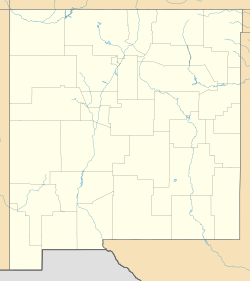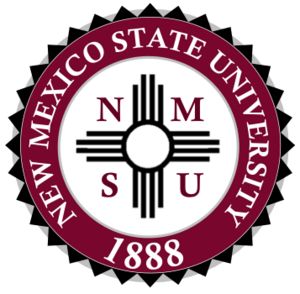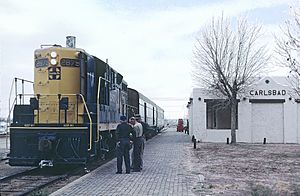Carlsbad, New Mexico facts for kids
Quick facts for kids
Carlsbad, New Mexico
|
||
|---|---|---|
|
City
|
||

Eddy County Courthouse
Carlsbad Museum and Art Center (l) Carlsbad Library (r) Carlsbad Municipal Building |
||
|
||
| Nicknames:
The Cavern City
The Pearl on the Pecos |
||
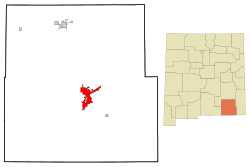
Location in the state of New Mexico
|
||
| Country | ||
| State | ||
| County | Eddy | |
| Founded | 1888 (as Eddy) | |
| Incorporated | 1893 (as Eddy) 1899 (as Carlsbad) |
|
| Government | ||
| • Type | Mayor-council government | |
| Area | ||
| • City | 31.79 sq mi (82.34 km2) | |
| • Land | 31.52 sq mi (81.63 km2) | |
| • Water | 0.28 sq mi (0.72 km2) | |
| Elevation | 3,127 ft (953 m) | |
| Population
(2023 estimate)
|
||
| • City | 31,499 | |
| • Density | 1,022.91/sq mi (394.94/km2) | |
| • Urban | 31,499 | |
| Demonym(s) | Carlsbadian | |
| Time zone | UTC−07:00 (MST) | |
| • Summer (DST) | UTC−06:00 (MDT) | |
| ZIP Codes |
88220-88221
|
|
| Area code(s) | 575 | |
| FIPS code | 35-12150 | |
| GNIS feature ID | 2409985 | |
| Primary airport | Cavern City Air Terminal CNM |
|
Carlsbad is a city in Eddy County, New Mexico, United States. It's the main city in the Carlsbad-Artesia area. Carlsbad is located in southeastern New Mexico, right on the Pecos River. It's also at the eastern edge of the Guadalupe Mountains.
Carlsbad is an important place for mining a mineral called potash. It's also known for producing oil and gas. Plus, it's a popular spot for tourists! Many famous places are nearby, like Carlsbad Caverns National Park and Guadalupe Mountains National Park.
Contents
History of Carlsbad
How Carlsbad Got Its Name
Carlsbad started as a town called Eddy on September 15, 1888. It was named after Charles B. Eddy, who owned a livestock company. People from England, Switzerland, France, and Italy helped build up this area in the late 1800s.
Later, people found special mineral springs nearby that were thought to be good for health. So, the town decided to change its name to Carlsbad. This new name came from a famous European spa called Karlsbad, Bohemia. That spa was named after Charles IV, Holy Roman Emperor. In 1918, Carlsbad grew big enough to officially become a city.
Building the City with Water
Carlsbad grew a lot because of its water system. Ranchers realized they could use water from the Pecos River to water their lands. Many projects were built to create an irrigation system for the town. The Avalon Dam was built upstream. Canals then brought water into town.
A special structure called the Pecos River Flume was built where the canals met the river. It's often called the only place where a river crosses itself! This helped control the water flow.
Early Travel and Discoveries
Before the railroad arrived in 1891, visitors came by train to Toyah, Texas. From there, they had to travel 90 miles by buggy to Carlsbad. Most early buildings in Carlsbad were made from local bricks. One of the few remaining buildings made with these bricks is the old First National Bank.
A big discovery happened in 1901 when cowboys rediscovered Carlsbad Caverns. It was first known as "Bat Cave." This amazing cave system later became Carlsbad Caverns National Park in 1930. This park brought a lot of fame to Carlsbad.
Potash Mining and Waste Storage
In 1925, a mineral called potash was found near Carlsbad. Potash is used as a fertilizer. For many years, Carlsbad was the main supplier of potash in America. When the potash market slowed down in the 1960s, people in Carlsbad looked for new ways to support the city.
They worked to create the Waste Isolation Pilot Plant (WIPP). This is a special site where low-level nuclear waste is stored safely deep underground in salt beds. Construction for WIPP began in 1980, and the first waste arrived in 1999.
Today, Carlsbad is experiencing a "boom" because of its oil and natural gas production. This has created many jobs, and more families are moving to the city.
Carlsbad in Movies
Carlsbad and its amazing caves have been used as filming locations for several movies.
Movies Filmed in Carlsbad
Some movies that were filmed right in the city of Carlsbad include:
- The Honkers (1972)
- Guitar Man (2015)
- I'll Be There with You (2006)
- Do It for Uncle Graham (2004)
- À l'ouest du Pécos (1993)
Movies Filmed in the Carlsbad Area
The famous Carlsbad Caverns have been a popular spot for movie makers.
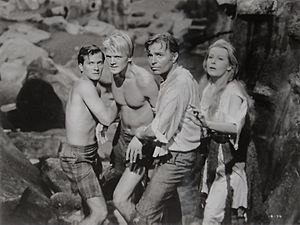
- Journey to the Center of the Earth (1959), starring James Mason and Pat Boone, used the caverns as a main location.
- Gene Roddenberry, who created Star Trek, made a TV movie called Genesis II (1973). In this science fiction film, the main character wakes up from suspended animation in the Carlsbad Caverns in the future.
- Jonathan Livingston Seagull (1973)
- The Bat People (1974)
- Earth vs. the Spider (1958)
- King Solomon's Mines (1950)
Geography and Climate
Where is Carlsbad Located?
Carlsbad is located in the northern part of the Chihuahuan Desert. It sits in the lower Pecos River Valley. The city is about 3,295 feet (1,004 meters) above sea level.
The United States Census Bureau says Carlsbad covers about 31.79 square miles (82.34 square kilometers). Most of this area is land, but about 0.28 square miles (0.72 square kilometers) is water. The Pecos River flows through Carlsbad, creating the Lake Carlsbad recreation area.
What is Carlsbad's Climate Like?
Carlsbad has a hot semi-arid climate. This means it gets a moderate amount of rain each year, mostly in July.
- Winters are usually dry and mild, but temperatures often drop below freezing at night.
- Springs are warm, but can sometimes get very hot.
- Summers are very hot, which is common for southern New Mexico. Temperatures often go above 100°F (38°C). During summer, the North American Monsoon can bring heavy rain and floods, which helps cool things down a bit.
- Fall is generally warm, but can also be cold.
The highest temperature ever recorded in Carlsbad was 114°F (46°C) in June 1994. The lowest was -16°F (-27°C) in January 1962. Eddy County has also had 53 tornadoes since 1950.
| Climate data for Carlsbad, New Mexico, 1991–2020 normals, extremes 1900–2021 | |||||||||||||
|---|---|---|---|---|---|---|---|---|---|---|---|---|---|
| Month | Jan | Feb | Mar | Apr | May | Jun | Jul | Aug | Sep | Oct | Nov | Dec | Year |
| Record high °F (°C) | 88 (31) |
100 (38) |
98 (37) |
101 (38) |
110 (43) |
114 (46) |
112 (44) |
111 (44) |
106 (41) |
101 (38) |
97 (36) |
86 (30) |
114 (46) |
| Mean maximum °F (°C) | 76.4 (24.7) |
80.9 (27.2) |
87.2 (30.7) |
93.3 (34.1) |
100.1 (37.8) |
106.3 (41.3) |
105.0 (40.6) |
103.3 (39.6) |
99.3 (37.4) |
93.4 (34.1) |
83.5 (28.6) |
76.4 (24.7) |
108.1 (42.3) |
| Mean daily maximum °F (°C) | 58.7 (14.8) |
64.0 (17.8) |
71.8 (22.1) |
80.1 (26.7) |
88.0 (31.1) |
96.6 (35.9) |
96.5 (35.8) |
95.3 (35.2) |
88.4 (31.3) |
79.7 (26.5) |
67.8 (19.9) |
58.6 (14.8) |
78.8 (26.0) |
| Daily mean °F (°C) | 44.3 (6.8) |
49.0 (9.4) |
56.3 (13.5) |
64.2 (17.9) |
72.9 (22.7) |
81.8 (27.7) |
83.6 (28.7) |
82.3 (27.9) |
75.3 (24.1) |
65.0 (18.3) |
53.0 (11.7) |
44.7 (7.1) |
64.4 (18.0) |
| Mean daily minimum °F (°C) | 30.0 (−1.1) |
34.0 (1.1) |
40.7 (4.8) |
48.3 (9.1) |
57.9 (14.4) |
67.0 (19.4) |
70.7 (21.5) |
69.4 (20.8) |
62.3 (16.8) |
50.2 (10.1) |
38.2 (3.4) |
30.7 (−0.7) |
50.0 (10.0) |
| Mean minimum °F (°C) | 17.3 (−8.2) |
20.6 (−6.3) |
25.8 (−3.4) |
33.8 (1.0) |
44.2 (6.8) |
56.5 (13.6) |
63.6 (17.6) |
62.0 (16.7) |
49.6 (9.8) |
34.2 (1.2) |
22.9 (−5.1) |
16.6 (−8.6) |
13.4 (−10.3) |
| Record low °F (°C) | −16 (−27) |
−13 (−25) |
8 (−13) |
23 (−5) |
31 (−1) |
42 (6) |
50 (10) |
48 (9) |
29 (−2) |
21 (−6) |
−1 (−18) |
−4 (−20) |
−16 (−27) |
| Average precipitation inches (mm) | 0.56 (14) |
0.45 (11) |
0.54 (14) |
0.45 (11) |
0.99 (25) |
1.07 (27) |
2.03 (52) |
1.63 (41) |
1.49 (38) |
1.01 (26) |
0.66 (17) |
0.67 (17) |
11.55 (293) |
| Average snowfall inches (cm) | 1.0 (2.5) |
0.4 (1.0) |
0.1 (0.25) |
0.0 (0.0) |
0.0 (0.0) |
0.0 (0.0) |
0.0 (0.0) |
0.0 (0.0) |
0.0 (0.0) |
0.0 (0.0) |
0.5 (1.3) |
0.7 (1.8) |
2.7 (6.85) |
| Average precipitation days (≥ 0.01 in) | 3.0 | 2.6 | 2.7 | 1.9 | 3.5 | 4.6 | 5.6 | 5.7 | 5.7 | 4.2 | 3.1 | 3.2 | 45.8 |
| Average snowy days (≥ 0.1 in) | 0.3 | 0.3 | 0.0 | 0.0 | 0.0 | 0.0 | 0.0 | 0.0 | 0.0 | 0.0 | 0.1 | 0.4 | 1.1 |
| Source 1: NOAA | |||||||||||||
| Source 2: National Weather Service | |||||||||||||
People of Carlsbad
Population Growth
| Historical population | |||
|---|---|---|---|
| Census | Pop. | %± | |
| 1900 | 963 | — | |
| 1910 | 1,736 | 80.3% | |
| 1920 | 2,205 | 27.0% | |
| 1930 | 3,708 | 68.2% | |
| 1940 | 7,116 | 91.9% | |
| 1950 | 17,975 | 152.6% | |
| 1960 | 25,541 | 42.1% | |
| 1970 | 21,297 | −16.6% | |
| 1980 | 25,496 | 19.7% | |
| 1990 | 24,952 | −2.1% | |
| 2000 | 25,625 | 2.7% | |
| 2010 | 26,138 | 2.0% | |
| 2020 | 32,238 | 23.3% | |
| U.S. Decennial Census | |||
In 2010, Carlsbad had 26,138 people living there. The city had 10,257 households. About 29.2% of these households had children under 18. The average household had 2.50 people.
Diversity in Carlsbad
Carlsbad is home to a diverse group of people:
- 74.7% White
- 1.9% Black or African American
- 1.3% Native American
- 1.0% Asian
- 15.28% from other races
- 3.1% from two or more races
- About 42.5% of the population were Hispanic or Latino.
The median age in Carlsbad in 2010 was 39.4 years old.
Carlsbad's Economy
Carlsbad's economy mainly relies on mining and tourism. The city is located over rich oil and gas areas. It also produces more potash than any other place in the United States.
The US Department of Energy has an office in Carlsbad that runs the Waste Isolation Pilot Plant (WIPP). This plant safely stores nuclear waste from defense sites.
Tourism is also a big part of the economy. Many people visit Carlsbad Caverns National Park, Guadalupe Mountains National Park, and the Living Desert Zoo and Gardens State Park. The annual Christmas on the Pecos Light Show is also a popular event.
Mining in Carlsbad
Potash is a mineral that contains potassium. It's used as a fertilizer to help plants grow. Large deposits of potash were found near Carlsbad in 1925.
Two companies, Mosaic Potash Carlsbad and Intrepid Potash, operate mines east of the city. These mines provide many jobs for people in Carlsbad and nearby communities.
Education in Carlsbad
Public Schools
The Carlsbad Municipal School District runs the public schools in Carlsbad. They also have a charter school called Jefferson Montessori Academy. The school board works to provide a good education for all children.
- Elementary Schools
- Cottonwood Elementary School
- Desert Willow Elementary School
- Early Childhood Education Center
- Edison Elementary School
- Hillcrest Preschool
- Monterrey Elementary School
- Ocotillo Elementary School
- Sunset Elementary School
- Jefferson Montessori Academy
- Secondary Schools
- Carlsbad Early College High School
- Carlsbad High School
- Carlsbad Intermediate School
- Carlsbad Sixth Grade Academy
- Jefferson Montessori Academy
Private Schools
- Faith Christian Academy
- St. Edwards Catholic School
Colleges and Universities
New Mexico State University has a branch campus in Carlsbad. It offers different programs, including certificates and degrees. About 2,000 students attend NMSU-Carlsbad. It started in 1950 as the state's first community college.
Eddy County Beauty College is also in Carlsbad. It offers programs for people who want to become beauticians.
Media and News
Print Media
Carlsbad has a local newspaper called the Carlsbad Current-Argus. It's published every day except Monday. Focus on Carlsbad is a magazine that comes out four times a year. It has articles about living, shopping, and visiting Carlsbad.
Radio Stations
Local Television
Channel 23 is a local TV station available on cable. It shows local news and special events. Some residents even host their own shows on topics like plant care or science. Classic movies are shown on Wednesdays.
Sports and Recreation
Carlsbad used to have a professional baseball team called the Carlsbad Bats. They were part of the Pecos League.
The city recently built a new youth sports complex. It has fields for softball and soccer. Many local and regional tournaments are held there each year.
Carlsbad High School has many sports teams. They compete in football, baseball, softball, basketball, track and field, golf, tennis, men's and women's soccer, swimming, wrestling, and rodeo.
The Carlsbad Velo Cycling Club is a local bicycle club. They host a big bike race called the Cavern City Classic Omnium. They also have weekly rides on Saturdays, which are a great way to see the area. The Carlsbad Runner's Club organizes annual running and walking races.
Transportation and Services
Major Roads
Two main highways run through Carlsbad:
- US Highway 62/180
- US Highway 285
Public Transportation
The Carlsbad Municipal Transit System (CMTS) provides public transportation. It offers bus routes and a dial-a-ride service within the city. CMTS helps people with disabilities, seniors, students, and the general public get around.
Greyhound Lines also has a bus stop in Carlsbad for longer trips.
Airports
Carlsbad has a regional airport called Cavern City Air Terminal (CNM). It offers flights to Albuquerque and Dallas/Fort Worth.
Other nearby airports include:
- Roswell International Air Center (ROW), about 73 miles north.
- Lea County Regional Airport (HOB), about 67 miles east.
- El Paso International Airport (ELP), about 158 miles west.
- Midland International Airport (MAF), about 144 miles southeast.
Train Services
The BNSF Railway provides freight train service in Carlsbad. They mainly transport goods for the local potash mines. There is no passenger train service in Carlsbad right now. The old train station building is still standing.
City Services
Xcel Energy provides electricity to Carlsbad. New Mexico Gas Company provides natural gas. The City of Carlsbad is in charge of providing drinking water and treating wastewater. They also collect trash from residents.
Healthcare
Carlsbad Medical Center is the main hospital in the area. It's a 127-bed hospital with a 24-hour emergency room. The town also has other health services like clinics for dialysis and imaging. The Carlsbad Mental Health Association offers mental health services and counseling.
Research and Technology
Carlsbad has several research facilities. These include the Carlsbad Environmental Monitoring and Research Center and the National Cave and Karst Research Institute. The United States Department of Energy also has offices in Carlsbad, including parts of Sandia National Labs and Los Alamos National Laboratory. The city also has an industrial park for advanced manufacturing and training.
Fun Places to Visit
- Carlsbad Caverns National Park: Amazing underground caves, about 20 miles southwest.
- Carlsbad Museum & Art Center: Learn about the city's history and see art.
- Carlsbad Skate Park: A place for skateboarding and scootering.
- The Cascades of Carlsbad: Beautiful waterfalls and water features.
- Cavern City Renaissance Festival: A fun festival with a medieval theme.
- Guadalupe Mountains National Park: Another national park with mountains, about 54 miles southwest in Texas.
- Lincoln National Forest: A large forest area, about 40 miles west.
- Living Desert Zoo and Gardens State Park: A zoo that features a painting bear named Maggie Oso! She paints with her paws using non-toxic paints.
- National Cave and Karst Research Institute: Learn about caves and how they form.
- Pecos River Flume: The unique spot where the Pecos River crosses itself.
- Project Playground: A fun playground for kids.
- The Artist Gallery: A place to see local art.
Famous People from Carlsbad
- Shane Andrews: A professional baseball player.
- Dan Blocker: An actor who played "Hoss" Cartwright in the TV show Bonanza. He used to be a teacher in Carlsbad.
- Bruce Cabot: An actor who was in the 1933 film King Kong.
- Jason D. Cunningham: An Air Force Pararescueman who saved many lives.
- Sam Etcheverry: A professional football player.
- F. Drew Gaffney: A scientist who flew on a Space Shuttle mission.
- Mark Jackson: A football player.
- Bob Kelly: An American Football League player.
- Trevor Rogers: A professional baseball pitcher.
- Cody Ross: A professional baseball outfielder.
- Barry Sadler: An author, musician, and veteran.
- Sonny Throckmorton: A singer and songwriter.
- Linda Wertheimer: A senior correspondent for National Public Radio.
- Jim White: The person who discovered and explored Carlsbad Caverns.
- John Wooten: A National Football League player.
Images for kids
See also
 In Spanish: Carlsbad (Nuevo México) para niños
In Spanish: Carlsbad (Nuevo México) para niños


